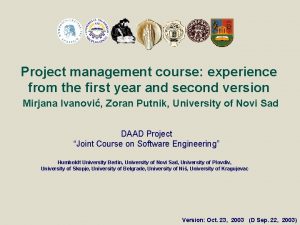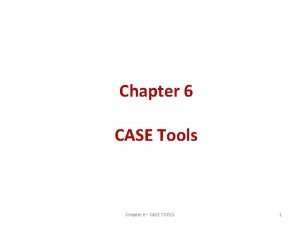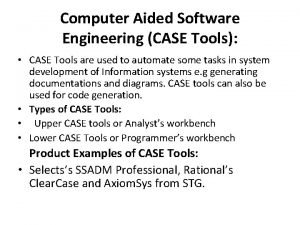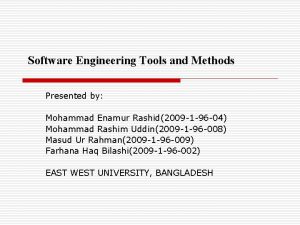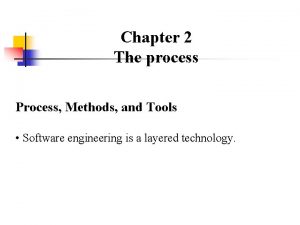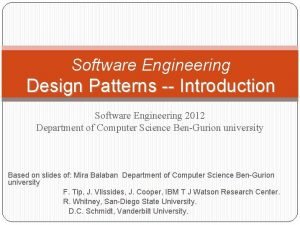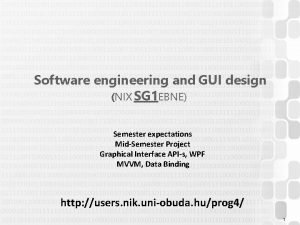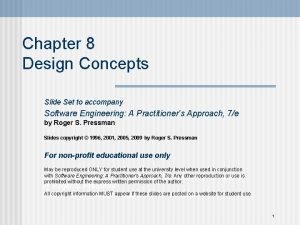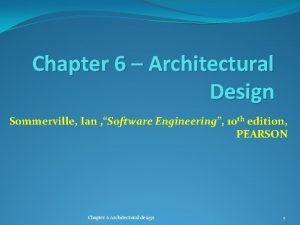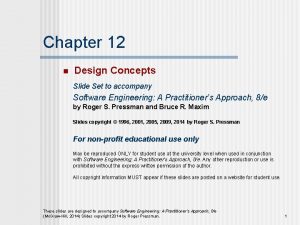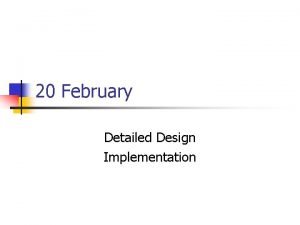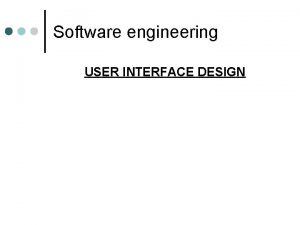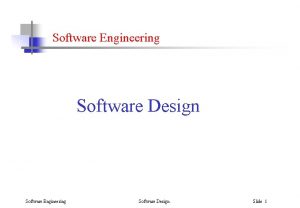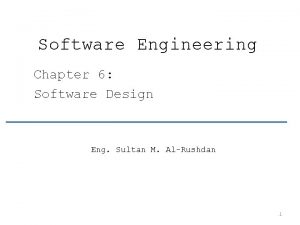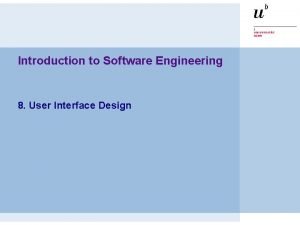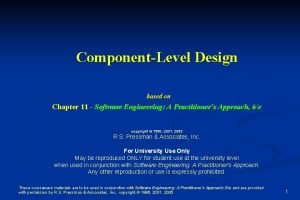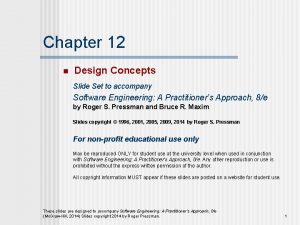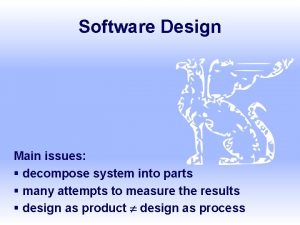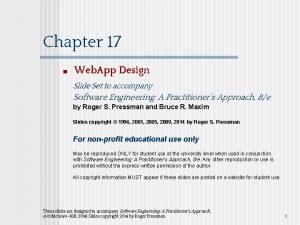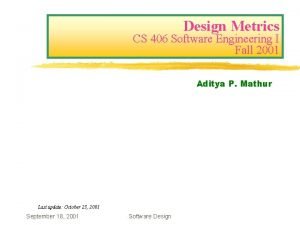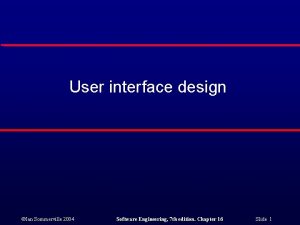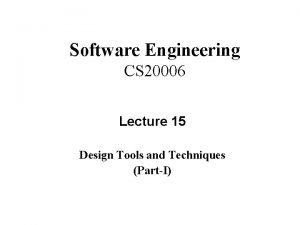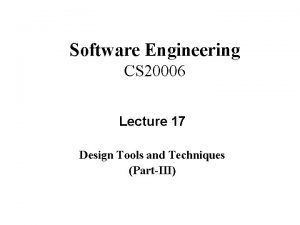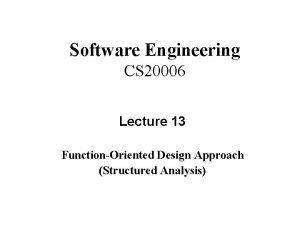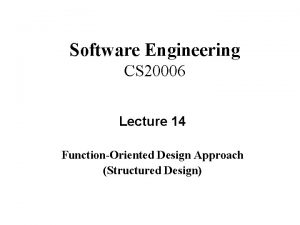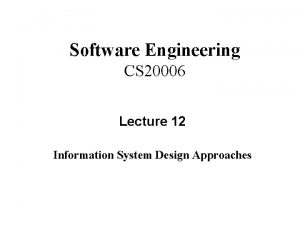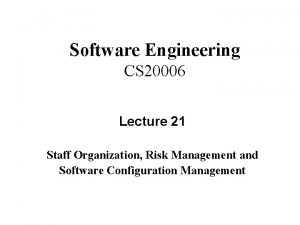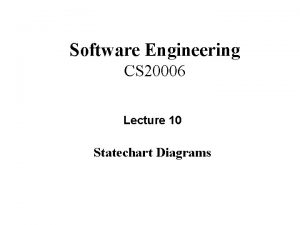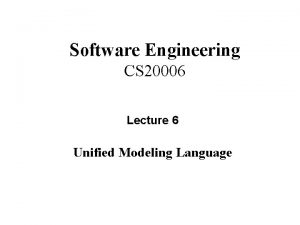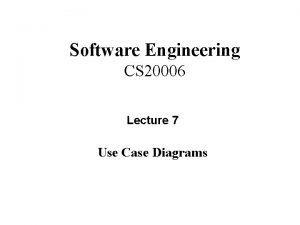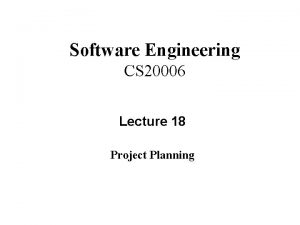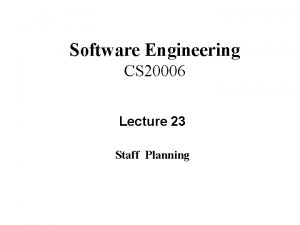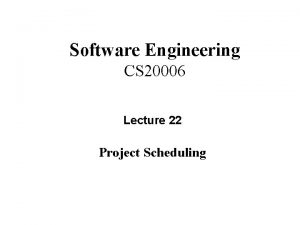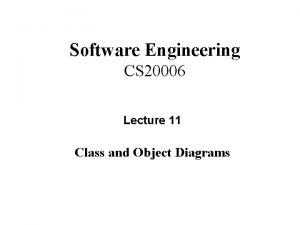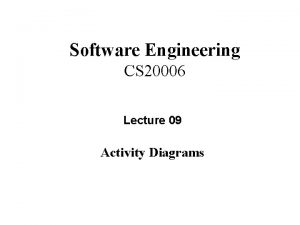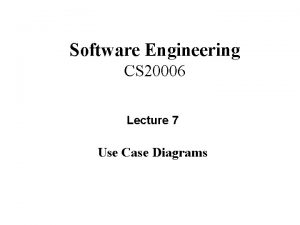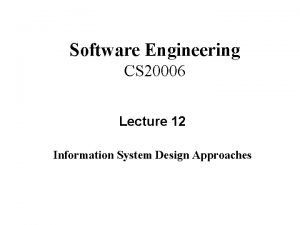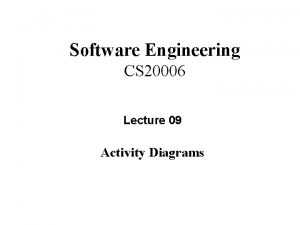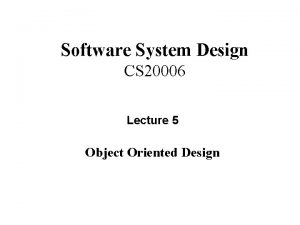Software Engineering CS 20006 Lecture 16 Design Tools





































- Slides: 37

Software Engineering CS 20006 Lecture 16 Design Tools and Techniques (Part-II) 11 March, 2020 Software Engineering (CS 20006) DSamanta, IIT Kharagpur

Entity Relationship Diagram 11 March, 2020 Software Engineering (CS 20006) DSamanta, IIT Kharagpur

Basic Concepts and Notations on Entity Relationship Diagram 11 March, 2020 Software Engineering (CS 20006) DSamanta, IIT Kharagpur

What is an ERD? • An Entity Relationship Diagram (ERD) is a graphical representation of an organization’s data storage requirements • ERDs are abstractions of the real world, which simplify the problem to be solved while retaining its essential features 11 March, 2020 Software Engineering (CS 20006) DSamanta, IIT Kharagpur

Why ERD? • Entity relationship diagrams are used to – Identify the data that must be captured, stored and retrieved in order to support the activities performed by an organization – A major data modeling tool and help to organize the data in the project into entities and define the relationship between entities – It enables the analyst to produce a good database structure so that the data can be stored and retrieved in a most efficient manner 11 March, 2020 Software Engineering (CS 20006) DSamanta, IIT Kharagpur

Composition of ERD • Entity relationship diagrams have three components – Entities – Attributes – Relationships 11 March, 2020 Software Engineering (CS 20006) DSamanta, IIT Kharagpur

Entity in ERD • Entities – An entity is anything real or abstract about which we want to store data. In short, anything, which an organization needs to store data about – Entity types fall into five classes • Roles e. g. Employee, Student • Events e. g. Payment, Borrow • Locations e. g. Campus, City • Tangible things or concepts e. g. Department, Book 11 March, 2020 Software Engineering (CS 20006) DSamanta, IIT Kharagpur

Representation Entity • Entities – Entities are represented on the diagram by labeled boxes 11 March, 2020 Software Engineering (CS 20006) DSamanta, IIT Kharagpur

Entity Sub-type • Entities – Sometimes it is useful to generalize a group of entities Example CAR, SHIP and AEROPLANE all are type of VEHICLE 11 March, 2020 Software Engineering (CS 20006) DSamanta, IIT Kharagpur

Attributes in ERD • Attributes – Entities are further described by their attributes (also called data elements) – Theses are the smallest units of data that can be described in a meaningful manner Example: An EMPLOYEE entity may the following attributes 11 March, 2020 Software Engineering (CS 20006) DSamanta, IIT Kharagpur

Relationships in ERD • Relationships – A data relationship is a natural association that exist between one or more entities Example EMPLOYEE works in DEPARTMENT EQUIPMENT is allocated to PROJECT ESTEEM is a type of CAR 11 March, 2020 Software Engineering (CS 20006) DSamanta, IIT Kharagpur

One-to-one Relationships • Three types of relationship exist between two different entities • It is also called the cardinality (the number of occurrences of one entity for a single occurrence of the related entity) – One-to-one relationship – One-to-many relationship – Many-to-many relationship 11 March, 2020 Software Engineering (CS 20006) DSamanta, IIT Kharagpur

One-to-one Relationships • This type of relationship takes place when a single occurrence of an entity is related to just one occurrence of a second entity Example: PERSON owns a CAR is owned by a PERSON 11 March, 2020 Software Engineering (CS 20006) DSamanta, IIT Kharagpur

One-to-many Relationships • This type of relationship takes place when a single occurrence of an entity is related to many occurrence of a second entity Example: DEPARTMENT has EMPLOYEE works in DEPARMENT 11 March, 2020 Software Engineering (CS 20006) DSamanta, IIT Kharagpur

Many-to-many Relationships • This type of relationship takes place when many occurrence of an entity are related to many occurrence of a second entity Example: STAFF work in PROJECT assigned to STAFF 11 March, 2020 Software Engineering (CS 20006) DSamanta, IIT Kharagpur

Recursive Relationships • Relationship can exist between different occurrences of the same type of entity Example: EMPLOYEE manager EMPLOYEE NETWORK makes NETWORK 11 March, 2020 Software Engineering (CS 20006) DSamanta, IIT Kharagpur

Entity Relationship Diagram Methodology 11 March, 2020 Software Engineering (CS 20006) DSamanta, IIT Kharagpur

ERD Methodology 10 basic steps 1. 2. 3. 4. 5. 6. 7. 8. 9. 10. 11 March, 2020 Identify entities Find relationship Draw rough ERD Fill in cardinality Define Primary keys(s) Draw key-based ERD Identify attributes Map attributes Draw fully attributes Check results Software Engineering (CS 20006) DSamanta, IIT Kharagpur

A Simple Example A company has several departments. Each department has a supervisor and at least one employee. Employees must be assigned to at least one, but possibly more departments. At least one employee is assigned to a project, but an employee may be on vacation and not assigned to any projects. The important data fields are the names of the departments, projects, supervisors, and employees, as well as, the supervisor numbers, employee numbers and project numbers. 11 March, 2020 Software Engineering (CS 20006) DSamanta, IIT Kharagpur

1. Identify Entities Objective: Identify the roles, events, locations, tangible things or concepts about which the end-user want to store data A company has several departments. Each department has a supervisor and at least one employee. Employees must be assigned to at least one, but possibly more departments. At least one employee is assigned to a project, but an employee may be on vacation and not assigned to any projects. The important data fields are the names of the departments, projects, supervisors, and employees, as well as, the supervisor numbers, employee numbers and project numbers. Note: One tempted to make company an entity, but it is a false entity because it has only one instance in this problem. True entities must have more than one instance. 11 March, 2020 Software Engineering (CS 20006) DSamanta, IIT Kharagpur

2. Find Relationships Objective: Find the natural association between pair of entities using a relation ship matrix A company has several departments. Each department has a supervisor and at least one employee. Employees must be assigned to at least one, but possibly more departments. At least one employee is assigned to a project, but an employee may be on vacation and not assigned to any projects. 11 March, 2020 Software Engineering (CS 20006) DSamanta, IIT Kharagpur

3. Draw Rough ERD Objective: Put entities in rectangles and relationships on line segments connecting the entities 11 March, 2020 Software Engineering (CS 20006) DSamanta, IIT Kharagpur

4. Fill in Cardinality Objective: Determine the number of occurrences of one entity for a single occurrence of the related entity A company has several departments. Each department has a supervisor and at least one employee. Employees must be assigned to at least one, but possibly more departments. At least one employee is assigned to a project, but an employee may be on vacation and not assigned to any projects. From the description of the problem: • Each Department has exactly one Supervisor • A Supervisor is in charge of one and only one Department • Each Department is assigned to at least one Employee • Each Employee works for at least one Department • Each Project has at least one Employee working on it • An Employee is assigned to 0 or more project 11 March, 2020 Software Engineering (CS 20006) DSamanta, IIT Kharagpur

4. Fill in Cardinality From the description of the problem: • Each Department has exactly one Supervisor • A Supervisor is in charge of one and only one Department • Each Department is assigned to at least one Employee • Each Employee works for at least one Department • Each Project has at least one Employee working on it • An Employee is assigned to 0 or more project 11 March, 2020 Software Engineering (CS 20006) DSamanta, IIT Kharagpur

5. Define Primary Keys A company has several departments. Each department has a supervisor and at least one employee. Employees must be assigned to at least one, but possibly more departments. At least one employee is assigned to a project, but an employee may be on vacation and not assigned to any projects. The important data fields are the names of the departments, projects, supervisors, and employees, as well as, the supervisor numbers, employee numbers and project numbers. The Primary keys are • Department name • Supervisor number • Employee number • Project number 11 March, 2020 Software Engineering (CS 20006) DSamanta, IIT Kharagpur

6. Draw Key-based ERD Objective: Eliminate many-to-many relationship and include primary and foreign key in each entity 11 March, 2020 Software Engineering (CS 20006) DSamanta, IIT Kharagpur

6. Draw Key-based ERD 11 March, 2020 Software Engineering (CS 20006) DSamanta, IIT Kharagpur

7. Identify Attributes Objective: Name the information details (fields), which are essential to the system under development The only attributes indicated are the names of A company has several departments. Each department has a supervisor and at least one employee. Employees must be assigned to at least one, but possibly more departments. At least one employee is assigned to a project, but an employee may be on vacation and not assigned to any projects. The important data fields are the names of the departments, projects, supervisors, and employees, as well as, the supervisor numbers, employee numbers and project numbers. 11 March, 2020 Software Engineering (CS 20006) DSamanta, IIT Kharagpur

8. Map Attributes Objective: For each attribute, match it with exactly one entity that it describes 11 March, 2020 Software Engineering (CS 20006) DSamanta, IIT Kharagpur

9. Draw Fully Attributed ERD Objective: Adjust the ERD from Step 6 to account for entities or relationships discovered in Step 8. 11 March, 2020 Software Engineering (CS 20006) DSamanta, IIT Kharagpur

9. Draw Fully Attributed ERD 11 March, 2020 Software Engineering (CS 20006) DSamanta, IIT Kharagpur

10. Draw Fully Attributed ERD Objective: Does the final ERD accurately depict the system data? The Final ERD appears to model the data in this system well. 11 March, 2020 Software Engineering (CS 20006) DSamanta, IIT Kharagpur

Data Dictionary Sample An example for a Banking System 11 March, 2020 Software Engineering (CS 20006) DSamanta, IIT Kharagpur

Data Dictionary Sample An example for a Banking System • Stored entries of the corresponding DD (Account) Account = {@Account. No + Account. Type + Balance + Customer. No} /* Storing balance information of an account */ Account. No = 9(10) Account. Type = [Savings, Current, Recurring, STD] Balance = Float 11 March, 2020 /*Unique bank account number */ /* Precise up to decimal points */ Software Engineering (CS 20006) DSamanta, IIT Kharagpur

Data Dictionary Sample An example for a Banking System • Stored entries of the corresponding DD (Customer) Customer = {@Customer. No + Name + Gender + PAN + Address + Telephone } /* Customer personal data */ Custmer. No = 9(8) Name = First. Name + (Middle. Name) + Last. Name First. Name = {Characters, length : 18} Last. Name = {Characters, length : 18} Middle. Name = {Characters, length : 18} Characters = {A-Z, a-z, 0 -9, ’, -} PAN = X(10) /*Personal Account Number */ Gender = [Male, Female] Address = /* Customer address, Length: 60 */ Telephone = 9(10) 11 March, 2020 /* Unique customer identity number */ /* Customer’s telephone number */ Software Engineering (CS 20006) DSamanta, IIT Kharagpur

Data Dictionary Sample An example for a Banking System • Stored entries of the corresponding DD (Transaction) Transaction = {@Transaction. No + Date + TType + Amount + (TPAccount) } /* Transaction record of each banking */ Transaction. No = 9(12) /* A unique transaction number */ TType = [Deposit, Withdrwal, Transfer] /* Transaction Type */ TPAccount = Account. No Balance = Float Date = /* Format : dd/mm/yyyy */ 11 March, 2020 /* Third party account involved in a transaction */ /* Precise up to decimal points */ Software Engineering (CS 20006) DSamanta, IIT Kharagpur

Problems to Ponder • Manual data dictionary vs. automatic data dictionary (in CASE) 11 March, 2020 Software Engineering (CS 20006) DSamanta, IIT Kharagpur
 Real time software design in software engineering
Real time software design in software engineering Design principles in software engineering
Design principles in software engineering Software engineering lecture notes
Software engineering lecture notes 01:640:244 lecture notes - lecture 15: plat, idah, farad
01:640:244 lecture notes - lecture 15: plat, idah, farad Srs in software engineering
Srs in software engineering Project management tools in software engineering
Project management tools in software engineering Types of case tools in software engineering
Types of case tools in software engineering Advantages of case tools in software engineering
Advantages of case tools in software engineering Software engineering tools and methods
Software engineering tools and methods Process methods and tools
Process methods and tools System procurement process in software engineering
System procurement process in software engineering Forward engineering in software engineering
Forward engineering in software engineering Software maintenance in software engineering ppt
Software maintenance in software engineering ppt Frank maurer
Frank maurer Metrics computer science
Metrics computer science Software crisis of 1960s
Software crisis of 1960s Software metrics example
Software metrics example User interface in software engineering
User interface in software engineering What is a design pattern in software engineering
What is a design pattern in software engineering Nix gui
Nix gui What is function oriented design in software engineering
What is function oriented design in software engineering Design concepts in software engineering
Design concepts in software engineering Architectural design in software engineering
Architectural design in software engineering Design principles in software engineering
Design principles in software engineering Detailed design in software engineering
Detailed design in software engineering Mode-based vs modeless interface in software engineering
Mode-based vs modeless interface in software engineering Software engineering slides
Software engineering slides Pseudocode examples
Pseudocode examples User interface design principles in software engineering
User interface design principles in software engineering Component-level design
Component-level design Interface analysis means understanding
Interface analysis means understanding Design concepts software engineering
Design concepts software engineering User interface design process in software engineering
User interface design process in software engineering Design issues in software engineering
Design issues in software engineering Design pyramid for webapps
Design pyramid for webapps Design for change in software engineering
Design for change in software engineering Design metrics in software engineering
Design metrics in software engineering User interface design process in software engineering
User interface design process in software engineering





